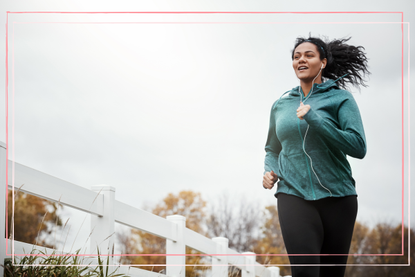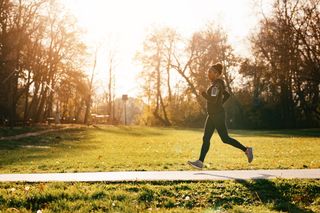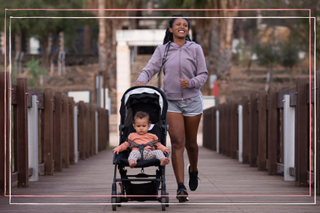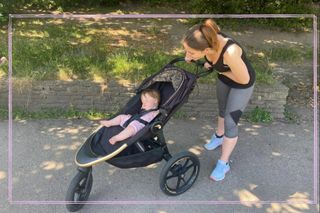How to start running for beginners – 14 tips for busy mums
Lace up those trainers and discover how to make running a rewarding part of your daily routine, no matter how hectic life gets


For busy mums juggling the demands of your family and work life, the prospect of adding running to the mix might seem overwhelming.
Couch to 5k finishers will vouch for the fact that running can be a transformative ally for mums, especially when it comes to postnatal exercise. "Running is an ideal activity for busy mums, offering a plethora of benefits that contribute to your overall wellbeing," says pre- and postnatal expert and personal trainer, Amanda Place. "The act of running provides valuable 'me time' for mums to recharge and prioritise self-care, fostering a sense of empowerment and resilience. As a flexible exercise that can be adapted to various schedules, running becomes an accessible and efficient way for busy mums to invest in their physical and mental health amidst their demanding routines."
Those benefits are even more prominent if you run outdoors too, according to a study published in the International Journal of Environmental Research and Public Health that proves you benefit from being exposed to nature which, in turn, can reduce stress and boost your mental wellbeing. There are more than just physical benefits to running too: according to Strava's 2023 report, 78 percent of people who use the fitness tracking app said exercise helps them combat feelings of loneliness, even if they were going it alone. Consider this the ultimate guide for how to fit running into your life, as we explore a beginner-friendly approach tailored for busy mums. From setting realistic goals to weaving running seamlessly into your hectic schedule, this guide is designed to help you lace up your trainers, hit the pavement and embrace the benefits of running without sacrificing your precious time or energy.
14 running tips for busy mums
1. Make it achievable
First thing's first: you need to be realistic with how many runs you can fit in each week. Pull out your diary and have a look at your non-negotiable commitments and decide whether going early in the morning (before the school run, perhaps) or evening after work, for example, would suit you best. "The key is to create a sustainable and enjoyable running routine that fits seamlessly into your busy lifestyle, allowing you to reap the physical and mental benefits of this accessible and invigorating form of exercise," says Amanda. If time is limited, even short bursts of running can contribute to your overall fitness, she adds.
If you've had an uncomplicated delivery, you can start with gentle exercises as soon as you feel ready, but the NHS advises to wait until after your six-week postnatal check before participating in high-impact activities such as aerobics or running. Furthermore, the NHS has suggested doing some pelvic floor exercises to strengthen the muscles in that area, as well as pushing your pram briskly when out walking with your baby. Find out how one of GoodtoKnow's testers found the Baby Jogger Summit X3 for running or walking with their baby on different terrains.
2. Team up with a workout buddy
Having a workout buddy will not only make running more fun, it'll help keep you accountable on the days you just want to stay at home, especially during the cold winter months. Use it as a social event and chance to catch up with a friend or family member – and you could even get a coffee afterwards as a reward. "This partnership not only enhances the physical benefits of running but also contributes to overall wellbeing by fostering positive connections and shared accomplishments," Amanda says.
3. Start slowly
It can be tempting to go hard and fast within the first week, but going hell-for-leather on a new running regime could cause an injury. To help your body adjust to the physical demands of running, start slowly. Amanda tells us: "This gradual progression helps prevent overexertion, reduces the risk of injuries, and allows for a smoother adjustment to the increased cardiovascular load. As you gradually build stamina and strength, you can progressively increase the duration and intensity of your runs."
GoodtoKnow Newsletter
Parenting advice, hot topics, best buys and family finance tips delivered straight to your inbox.
4. Start with walk-run intervals
Run-walk intervals are perfectly acceptable – encouraged, even – when you start a new running programme. Try doing one minute of running for every two minutes of walking to help beginners build up their cardiovascular fitness. "Similarly, programmes like Couch to 5K provide a well-structured and progressive plan, guiding mums through a series of walk-run intervals to gradually build running stamina," Amanda says.
5. Set yourself a goal
A clear and achievable goal provides a sense of purpose and direction, turning running into a purposeful activity rather than a routine chore. Amanda tells us: "Whether it's completing a certain distance, participating in a local race, or achieving a specific time, having a goal creates a tangible target to work towards. This not only adds structure to your running routine but also boosts accountability and commitment."
6. Never neglect a warm-up
Avoiding a warm-up is a common mistake that new runners make, but it's crucial to prepare your body for the physical demands of running and reduce the risk of injuries. "Start with light aerobic exercises like brisk walking or a slow jog for five to 10 minutes to gradually elevate your heart rate and increase blood flow to your muscles. Incorporate dynamic stretches targeting major muscle groups, such as leg swings, hip circles, and arm circles," Amanda suggests.
7. Consider your technique
For mums venturing into running, focusing on proper technique is paramount for a safe and enjoyable experience. Amanda explains the perfect running technique: "Start by maintaining an upright posture with a slight forward lean from the ankles, ensuring a straight line from the head to the heels. Land softly on the midfoot or forefoot rather than the heel, promoting a more efficient stride and reducing the risk of impact-related injuries. Keep the arms bent at a 90-degree angle and swing them naturally, syncing the motion with the stride. Avoid clenching the fists and strive for a relaxed upper body to conserve energy and reduce tension. Gradually increase the intensity and duration of your runs to allow the body to adapt."
8. Choose the right activewear for running
Don't underestimate the power of the proper running gear to make a difference to your runs – the material and technology of running kit can really help you go the extra mile. "Opting for moisture-wicking fabrics, such as polyester or blends with moisture-wicking technology, helps manage sweat and keeps the body dry during runs. Look for breathable materials and designs that promote air circulation, aiding in temperature regulation and preventing discomfort," Amanda suggests.
. High-waisted leggings or shorts with a comfortable waistband can provide support to the core, and choosing pieces with reflective elements enhances visibility, a particularly important safety consideration if running early in the morning or late in the evening."

9. Wear the correct footwear
Ideally, you need to be wearing trainers that are specifically designed for running to avoid minor things like blisters to the more detrimental elements like injuries. "Quality running shoes provide proper support, cushioning, and stability, which are crucial for the unique biomechanics of running," Amanda says. "Opt for well-fitted shoes that are designed for running to help with shock absorption and maintain proper alignment and posture for every run."
10. Invest in ventilated running gear
Ventilated running clothing, featuring breathable fabrics and strategically placed mesh panels, allows for effective moisture-wicking and improved air circulation. "This, in turn, helps regulate body temperature and keeps you cool and comfortable, even during demanding workouts," Amanda states. Investing in multi-functional activewear will help mums with limited time so they can go from their training run to the school run.
11. Invest in a shock absorber bra
Investing in a shock absorber bra (one that is designed to control your breasts when engaging in high impact activity like running) is a must for not just mums but all women. For mums who have been through pregnancy or breastfeeding, it's crucial to have a sports bra that fits well to provide proper support for their breast tissue that may have changed. "A shock-absorber bra provides extra support, minimising breast movement during physical activity and reducing strain on the delicate ligaments," Amanda explains. "This not only enhances comfort but also helps prevent sagging and discomfort associated with inadequate support."
12. Don't forget the cool down
As with the warm up, cooling down by stretching is going to help with that post-run recovery. Amanda tells us: "Focus on major muscle groups used during running, including the calves, hamstrings, quadriceps, hips, and lower back. A classic calf stretch, where you lean against a wall with one leg extended back, helps alleviate tightness in the calves.
"For the hamstrings, a seated or standing forward bend can be effective. The quadriceps can be stretched by pulling one foot toward the glutes while standing. To address hip tightness, incorporate a hip flexor stretch or pigeon pose. Finally, a gentle lower back stretch, such as a seated twist or cat-cow stretch, can release tension. Hold each stretch for 15-30 seconds, focusing on controlled breathing and avoiding bouncing."
13. What to eat before a run
Some pre-run fuel can work wonders, but you need to get the timing right so it doesn't effect your performance. "Consume a balanced meal or snack about one to three hours before your run, focusing on easily digestible carbohydrates, moderate protein, and a small amount of healthy fats. Whole-grain toast with nut butter and banana, avocado toast with eggs, or a bowl of porridge with berries and honey are excellent choices to start with," says Amanda.
14. How to refuel from a run
A review published in the Journal of International Society of Sports Nutrition suggests that after a solid run, munching down on some carbs and protein within 30 minutes is the perfect time to refuel your muscle energy (that stored glucose). Aim for a three to one ratio of carbs to protein for a decent refuel.
Amanda explains: "Carbohydrates are essential for restoring glycogen levels depleted during exercise, and they can be obtained from sources like whole grains, fruits, and vegetables. Protein is important for muscle repair after exercise and can be found in lean beef, poultry, fish, eggs, or plant-based options like beans, legumes, nuts and seeds. And don’t forget to rehydrate with water or electrolytes to replace fluids lost through sweat." Following a high protein diet and eating high protein foods beforehand will also help your muscles adapt and develop to the regime in the longer term.
Our running must-haves
- John Lewis: Up to 50% off selected Sports
- Under Armour: Save up to 50% off Women's Gym Wear
- Nike: Buy 2, get 25% off
- Shock Absorber: Get an extra 10% off your first order
- On Running: Save up to 50% off online
- HOKA: Save up to 40% off online
- Adidas: Up to 50% off in winter sale

Amanda Place is a personal trainer and pre- and postnatal exercise expert. She has over a decade of experience in the fitness industry, including a Level 5 Diploma in Integrative Health and Nutrition Coaching, Level 3 Diploma in Gym Instructing and Personal Training and First Class Honours Degree in Kinesiology. Amanda is also the founder of Sculptrition – an online coaching platform that features a range of classes from Pilates and Yoga to HIIT and strength training, as well as on-demand postnatal workouts that are ideal for busy mums.
Continue reading

From building healthy family relationships to self-care tips for mums and parenting trends - Daniella also covers postnatal workouts and exercises for kids. After gaining a Print Journalism BA Hons degree and NCTJ Diploma in Journalism at Nottingham Trent University, Daniella started writing for Health & Wellbeing and co-hosted the Walk to Wellbeing podcast. She has also written for Stylist, Natural Health, The Sun UK and Fit & Well. In her free time, Daniella loves to travel, try out new fitness classes and cook for family and friends.
-
 Worried about your teen 'being smelly'? They can't help it, according to scientists, and help is on its way to ease the problem
Worried about your teen 'being smelly'? They can't help it, according to scientists, and help is on its way to ease the problemWe know that puberty can cause all sorts of smells to emanate from teens - now scientists have revealed exactly what you're smelling, and how evolution contributed.
By Lucy Wigley Published
-
 Parenting coach shares 4 'powerful' reframes to try next time it feels like your kid is pushing all your buttons (and #4 is a game changer)
Parenting coach shares 4 'powerful' reframes to try next time it feels like your kid is pushing all your buttons (and #4 is a game changer)A parenting coach has shared four ways parents can reframe their thoughts when their kid has big emotions. Giving them a try could offer big results in little time.
By Lucy Wigley Published


